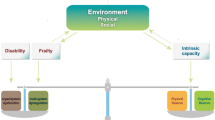Abstract
Physical frailty and loss of muscular mass (sarcopenia) are believed to be predictors of age-related conditions, such as disability and loss of autonomy. In this paper, I show that what in political and moral philosophy has come to be known as “the capability approach” may indeed provide much needed conceptual clarification in the area of frailty research. Other than being useful at the theoretical level, the capability approach can definitely help in the implementation of clinical guidelines and public health measures aimed at translating the results that are accumulating from frailty research. I will first briefly review the main philosophical tenets of the capability approach, and then analyze how they relate to current debates about frailty and sarcopenia by introducing the notion of “enablement”. Finally, I will show how my analysis bears on both clinical research in this domain and public policy aimed at tackling some of the age-related issues in an aging society.
Similar content being viewed by others
References
Sen A (1999) Development as freedom. Oxford University Press, Oxford
Sen A, Nussbaum MC (eds) (1993) The quality of life. Clarendon Press, New York
Sen A (1981) Poverty and famines: an essay on entitlement and deprivation. Oxford University Press, Oxford
Sen A (1992) Inequality reexamined. Oxford University Press, Oxford
Nussbaum MC (1992) Human functioning and social justice in defense of Aristotelian essentialism. Political Theory 20:202–246. doi:10.1177/0090591792020002002
Morley JE, Vellas B, Abellan van Kan G et al (2013) Frailty consensus: a call to action. J Am Med Dir Assoc 14:392–397. doi:10.1016/j.jamda.2013.03.022
Fried LP, Tangen CM, Walston J et al. (2001) Frailty in older adults: evidence for a phenotype. J Gerontol A Biol Sci Med Sci 56:M146–M156. doi:10.1093/gerona/56.3.M146
Rockwood K, Song X, MacKnight C et al (2005) A global clinical measure of fitness and frailty in elderly people. CMAJ 173:489–495. doi:10.1503/cmaj.050051
Rosenberg IH (1997) Sarcopenia: origins and clinical relevance. J Nutr 127:990S–991S
Rolland YM, Czerwinski S, Abellan Van Kan G et al (2008) Sarcopenia: its assessment, etiology, pathogenesis, consequences and future perspectives. J Nutr Health Aging 12:433–450
Cesari M, Vellas B (2012) Sarcopenia: a novel clinical condition or still a matter for research? J Am Med Dir Assoc 13:766–767. doi:10.1016/j.jamda.2012.07.020
Fielding RA, Vellas B, Evans WJ et al (2011) Sarcopenia: an undiagnosed condition in older adults. Current consensus definition: prevalence, etiology, and consequences. International working group on sarcopenia. J Am Med Dir Assoc 12:249–256. doi:10.1016/j.jamda.2011.01.003
Merskey H (1986) Variable meanings for the definition of disease. J Med Philos 11:215–232. doi:10.1093/jmp/11.3.215
Nordenfelt L (2007) The concepts of health and illness revisited. Med Health Care Philos 10:5–10. doi:10.1007/s11019-006-9017-3
Jacobsen DE, Samson MM, Kezic S, Verhaar HJ (2007) Postmenopausal HRT and tibolone in relation to muscle strength and body composition. Maturitas 58:7–18. doi:10.1016/j.maturitas.2007.04.012
Artaza JN, Bhasin S, Magee TR et al (2005) Myostatin inhibits myogenesis and promotes adipogenesis in C3H 10T(1/2) mesenchymal multipotent cells. Endocrinology 146:3547–3557. doi:10.1210/en.2005-0362
Acknowledgements
The present work was funded by a grant from the Innovative Medicines Initiative—Joint Undertaking (IMI-JU 115621). The author is grateful to Matteo Cesari, Marco Canevelli, Michele Loi, Régis Le Lain, and the journal’s reviewers for very helpful discussions and comments on the previous drafts.
Author information
Authors and Affiliations
Corresponding author
Ethics declarations
Conflict of interest
The author declares that he has no conflict of interest.
Ethical approval
This article does not contain any studies with human participants or animals performed by any of the authors.
Informed consent
For this type of study, informed consent is not required.
Rights and permissions
About this article
Cite this article
Blasimme, A. Physical frailty, sarcopenia, and the enablement of autonomy: philosophical issues in geriatric medicine. Aging Clin Exp Res 29, 59–63 (2017). https://doi.org/10.1007/s40520-016-0714-3
Received:
Accepted:
Published:
Issue Date:
DOI: https://doi.org/10.1007/s40520-016-0714-3



